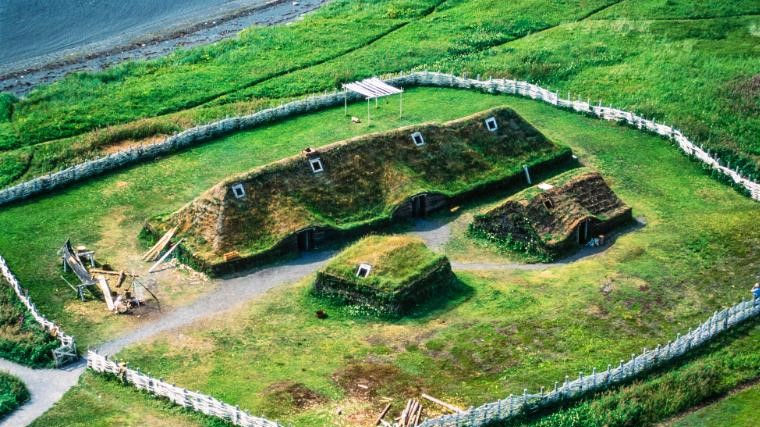VIKINGS WERE IN THE AMERICAS EXACTLY A THOUSAND YEARS AGO
- Livros Vikings

- Oct 20, 2021
- 4 min read
The Vikings used their longships to cross the Atlantic Ocean and settled in Canada as early as 1021, according to a new study providing the first exact date of Europeans in the Americas.

The study examined wooden artifacts from a previously undated Viking settlement in Newfoundland, which provide the earliest known record of humans crossing the Atlantic to reach the Americas.
The site, known as L'Anse aux Meadows, is located on Newfoundland's northern peninsula.
Researchers landed on a definitive date thanks to two unlikely sources: chopped wood and a solar storm that occurred more than a thousand years ago.
When the Vikings reached L'Anse aux Meadows, they chopped down trees using metal blades, which weren't produced by the Indigenous population living in the area at the time. The wooden pieces, left behind at the settlement, came from three different trees.
This reconstructed Viking-age building sits adjacent to the site of L'Anse aux Meadows.
Within those pieces were tree rings -- including a clear marker for the year 993. The year before, scientists know that a massive solar storm occurred, releasing a stream of cosmic rays, or highly energetic particles, from the sun at nearly the speed of light.
This left behind a noticeable and distinct signature in the tree rings for the year 993.
"The distinct uplift in radiocarbon production that occurred between 992 and 993 AD has been detected in tree-ring archives from all over the world," said Michael Dee, lead study author and associate professor of isotope chronology at the University of Groningen in the Netherlands.
All three wooden objects show the same signal from the solar storm exactly 29 growth rings before meeting the bark's edge.
"Finding the signal from the solar storm 29 growth rings in from the bark allowed us to conclude that the cutting activity took place in the year 1021 AD," said Margot Kuitems, study coauthor and postdoctoral researcher at the University of Groningen.
A study including these findings published Wednesday in the journal Nature.

Global exploration
Securing this date suggests this is the earliest known presence of Europeans in the Americas ahead of Christopher Columbus, as well as the earliest evidence in all of human migration and exploration that the Atlantic had been crossed, Dee said.
Vikings also established a presence in Iceland and Greenland to the west before arriving at the L'Anse aux Meadows site.
"It is thought that the Vikings ventured west to find new raw materials, most notably wood," Dee said. "By traveling between the continents for such materials, it has been described as the first step in globalization."
While the exact number of trips to the Americas, or how long they stayed there, is unclear, current evidence shows it was likely a short-lived stay for the Vikings. But there is evidence at the L'Anse aux Meadows site to show that Vikings explored areas south of Newfoundland while they were in the Americas.
Previous attempts to understand when Vikings reached the Americas have been rooted in the Icelandic Sagas, but these were once oral histories written down centuries after they actually occurred. The Sagas are filled with fantastical notes, but they also point to potential encounters between Vikings and the Indigenous people of the Americas. Some of these events were described as amiable, and others violent.
When cross-checked with medieval texts, including a recently discovered one, it appears that other Europeans were aware Vikings had reached a new land across the Atlantic. Combining modern research techniques and the discovery of other texts could help establish a timeline for Vikings in the Americas, as well as who else knew about it, Dee said.

Retracing Viking tracks
But finding archaeological evidence to back up the stories in the Sagas is much harder.
"This date acts as an anchor point for the Icelandic Sagas," Dee said. "It is somewhat in keeping with date estimates based on these Sagas, and therefore adds some credibility to the stories they contain of exploration of the Americas and interaction with Indigenous inhabitants. In other ways, it is later than most Saga experts would have expected."
Previously, researchers believed Vikings were in the Americas by the late 990s or early 1000s.
"This either means the Vikings were there a little later in time, or they came and went over a longer time period, or they stayed at the site longer than most would have expected," Dee said.
Using cosmic ray events could help researchers study and date other historic sites thought to be Viking or medieval in origin, because there are at least two events that occurred during this period, in 775 and 993. Researchers are also trying to trace other solar storms, and so far, they've confirmed another one that occurred in 660 BC.
Previously, Dee's team has used this dating method on another historical site with an unknown age prior to exact-year radiocarbon dating.
Looking ahead, Dee and his colleagues want to delve deeper into the story of Norse exploration of the North Atlantic, he said. They are already applying their dating method to other "chronological questions" around the world.
"In time, it is hoped that such research will provide new and explanatory insights into the story of the human past," Dee said.
SOURCE: CNN
Strickland, Ashley. “Vikings were in the Americas exactly a thousand years ago”. CNN. New York. 20 oct. 2021. 20 oct.2021. <https://www.cnnbrasil.com.br/internacional/novo-estudo-sugere-que-vikings-estiveram-na-america-ha-exatamente-mil-anos/>.
Sign our Newsletter or add our WhatsApp to keep informed about the Viking World... Please, follow us in Social Medias.








Comments